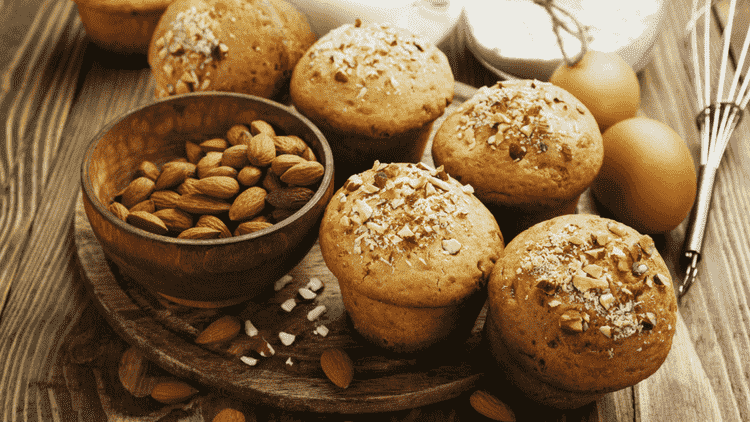Whether you want to put on muscle or lose body fat, changing your body composition comes down to calorie balance: Calories in vs calories out. There’s more to it than that, of course. But the bottom line is: If you want to gain muscle mass, you need to eat enough. Are you eating enough to fuel your workouts and gain muscle?
How many calories to gain muscle?
Your body needs extra calories to grow new muscle mass. After all, tissue doesn’t grow out of thin air. So you need to be in a moderate caloric excess if you want to grow muscle.
There are other benefits to being in a caloric excess in a gaining phase: More food will mean more nutrients, healthy fats, and vitamins, plus sufficient protein to spike MPS (muscle protein synthesis). If you’re undereating, you run the risk of compromising these important nutrition fundamentals.
Here’s a simple way to estimate your muscle-gain calorie intake.
Estimate your maintenance calories by calculating TDEE (total daily energy expenditure). TDEE is the total of your BMR (Basal Metabolic Rate – the amount of energy your body burns at rest), TEF (Thermic Effect of Food – the calories burned in the process of digesting your food), NEAT (Non-Exercise Activity Thermogenesis – calories burned through everyday activity outside of exercise), and TEA (Thermic Effect of Activity – calories burned during exercise or other high-energy activities).
Calculate your BMR:
Men = 66 + (13.7 x weight in kg) + (5 x height in cm) – (6.8 x age in yrs)
Women = 655 + (9.6 x weight in kg) + (1.8 x height in cm) – (4.7 x age in yrs)
TDEE is BMR x activity levels, so multiply your BMR (above) by 1.2 (sedentary, little to no activity), 1.375 (light exercise 1–3 times a week), 1.55 (moderate exercise 3–5 times a week), 1.725 (training 6–7 times a week), or 1.9 (training twice a day, or manual physical job).
You should now have (roughly) your TDEE – the amount of calories your body uses to fuel everything you do every day.
From here, you need to add a little more so that you can build new muscle. Start with TDEE + 10–15% as you’re gaining calories. Track your intake and stick to this for 2–4 weeks, then reassess and adjust up or down as necessary.
Stay on Track With These Meal Prepping Strategies >>
How much is too much?
If you eat too many calories above TDEE, you will gain body fat – and we’re guessing that you’d rather have a lean bulk. It’s a fine line to tread, but it is possible, if you’re willing to let go of the ultra-shredded look while you gain muscle.
It’s important to track your food during a gaining phase, just like you would if you were cutting. Track food, drinks, snacks, and all those extras, and make sure you are sticking to your gaining calories (TDEE + 10–15%). Any more than this and you are likely to gain weight quickly – and it won’t be muscle!
Making small increases and tracking your intake has a ton of benefits. You won’t gain excess fat quickly. You’ll be able to monitor fat gain and stay in control of the process. You’ll get a better understanding of what your true maintenance is. And you’ll be able to focus on quality food to give your body the nutrients it needs to grow.
Get it right and you should feel stronger, lift heavier, and have better training sessions – plus you’ll be able to see the results of your hard work!
Macro split for muscle gain
Your macro split will probably be a little different from a cutting diet. You’ll still need to keep protein sufficiently high to support muscle gain, but fats can remain at healthy levels. This leaves plenty of space for extra carbohydrates, which is good news for your training. Carbs will fuel awesome training sessions, help you recover well, and even support a better night’s sleep.
Try a 30% protein, 50% carbohydrate, and 20% fats macro split to start with and adjust as necessary. Remember that there’s no need to go super-high in protein as long as you are eating protein at every meal and snack and getting at least 30g of protein every 3–4 hours.
Solutions to hardgainer problems
Are you really a genetic hardgainer? Or are you simply not eating enough to fuel your output? Plenty of guys who say they are hardgainers or ectomorphs are actually just super-active (the kind of person who never sits still) and/or have a small appetite. Just because you have trouble eating enough now, it doesn’t mean you’re destined to be a hardgainer for life!
Simple ways to eat more
Cut the food volume
Eating high-volume foods will fill you up, making it difficult to actually eat enough calories. So ditch salads, stir fries, puffed cereal, and rice cakes in favor of denser foods. Think about getting the most bang for your buck with every mouthful.
Add extras
This is the opposite to a dieting mentality! If you need more calories, think about adding extras: Grated cheese, cream, ketchup and other sauces, nuts, and seeds … you get the idea. What can you add to your food, drinks, and snacks to bump up the calories?
Leave the diet habits behind
Lean bulking is not a time to be dieting, so leave your cutting diet tips, tricks, and hacks behind. There will be plenty of time for those when you diet down to show off your new muscle gains!
Use shakes
Shakes can be a great way to get in calories with minimal fuss, food prep, and eating time. You can take a shake with you in the car or on the go, and have one between meals. Think beyond the protein shake: Add carbs (using banana, honey, oats, or a powdered carb like maltodextrin), protein (your choice of protein powder, plus dairy if you want), and healthy fats (nut butters are a popular choice!).
Eat what you enjoy
This is a simple tip that many hardgainers seem to ignore. If you don’t enjoy what you eat, why are you eating it? Sure, you need to focus on healthy and nutritious foods. But when you’re gaining, the sky’s the limit! So eat what you enjoy. Remember that we eat with all of our senses. So make meal times and snacks an enjoyable experience.
Eat more often
If you’re struggling to increase food volume, then increase food frequency instead. Add shakes between meals, add a mid-morning or mid-afternoon snack, have a healthy dessert after dinner, or add an extra protein serving before bed.
Make it easy for yourself
It can be very easy to go most of the day without eating, especially if you’re busy, travelling, or stressed. So make it easy for yourself. Have easy-to-eat snacks on hand (in your bag or desk drawer). Carry a favorite protein bar with you as an emergency snack. Prepare your food for work the next day, and be sure to include snacks and pre/post-workout nutrition. Prepare your food at the weekend so you have meals available during the week.
Stay on Track With These Meal Prepping Strategies >>
Intra-workout nutrition
Finally, be sure to fuel your training if you want to gain muscle. Don’t run on empty. Have a pre-training meal of carbs and protein, a shake (and maybe a piece of fruit) afterwards, and then a solid meal an hour or so after that. And consider drinking an intra-workout mix of carbs and BCAAs during your training session.
It’s growing time!






